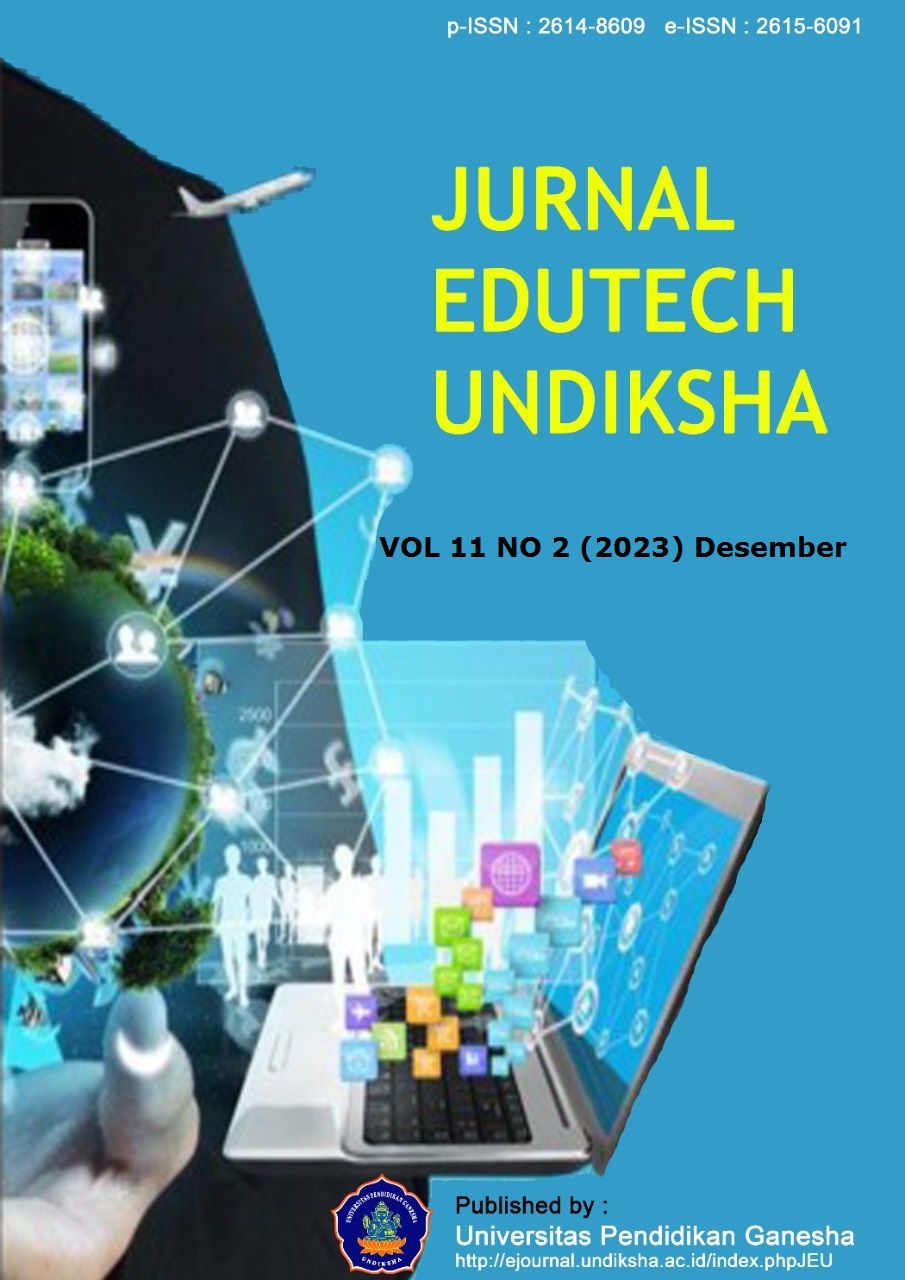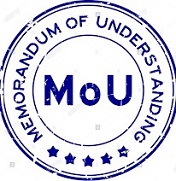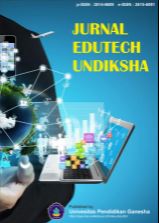Interactive PowerPoint Media on Thematic Learning in Primary School
DOI:
https://doi.org/10.23887/jeu.v11i2.60259Kata Kunci:
Learning Media, Interactive Powerpoint, ThematicAbstrak
Along with global technological advances, it affected all aspects of life, both in the economy, politics, culture, art and even in the world of education. Due to the lack of technology-based learning media, encouraging the development of useful PowerPoint interactive media in Grade IV Elementary Schools. The type of research used is development research (R&D) with the ADDIE development model. This development includes the analysis, design, development, implementation, and evaluation stages. Data collection uses a validation sheet filled out by material experts, linguists, and media experts and practicalities filled out by teachers and students. The test subjects in this study were students in grade IV Elementary School. The results showed the validity level was 92% for material, 90% for language and 95% for media, with a good category with an average of 92%. The level of practicality of the media shows an efficient category, with the results of the response questionnaire Obtaining a practicality percentage of 96%. While the results of the student response questionnaire with a practicality percentage of 93%. Based on the results of these data, interactive PowerPoint on thematic learning in schools can be used in the field because it has been declared valid and practical.
Referensi
Anggraini, T. S., & Reinita. (2021). Pengembangan Media Interaktif Articulate Storyline 3 Berbasis Kontekstual pada Pembelajaran Tematik Terpadu di Kelas IV Sekolah Dasar. Journal of Basic Education Studies, 5, 9853–9859. http://repository.unp.ac.id/48308/.
Anwar, Z., Kahar, M. S., Rawi, R. D. P., Nurjannah, N., Suaib, H., & Rosalina, F. (2020). Development of Interactive Video Based Powerpoint Media In Mathematics Learning. Journal of Educational Science and Technology (EST), 6(2), 167–177. https://garuda.kemdikbud.go.id/documents/detail/1712717.
Budiaji, W. (2013). The Measurement Scale and The Number of Responses in Likert Scale. Jurnal Ilmu Pertanian Dan Perikanan Desember, 2(2), 127–133. https://www.academia.edu/download/56440923/skalalikert.pdf.
Daulay, M. I. (2018). Developing Social Science-History’s Comics- Based Learning Media for the Fifth Grade of Primary School In Pekanbaru City. International Journal of Research in Counseling and Education, 1(1), 15. https://doi.org/10.24036/008za0002.
Dewi, N. P. S., Utari, & Sujana, I. W. (2022). E-Comic berbasis Problem Based Learning Muatan IPS Materi Jenis-Jenis Pekerjaan Kelas IV Sekolah Dasar. Jurnal Edutech Undiksha, 10(2), 253–261. https://doi.org/10.23887/jeu.v10i2.47044.
Dewi, R. S., & Aini, S. (2020). Pengembangan Media Pembelajaran Powerpoint Interaktif Berbasis Inkuiri Terbimbing pada Materi Larutan Penyangga. Ranah Research: Journal of Multidisciplinary Research and Development, 3(1), 162–171. https://doi.org/10.38035/rrj.v3i3.342.
El Khoury, R. M., & Mattar, D. M. (2012). PowerPoint in accounting classrooms: Constructive or destructive? International Journal of Business and Social Science, 3(10), 240–259. https://citeseerx.ist.psu.edu/document?repid=rep1&type=pdf&doi=a540b910d86300dac051a0238a2af3a8c3c2a226.
Firdawela, I., & Reinita, R. (2021). Pengembangan Media Pembelajaran Articulate Storyline Menggunakan Model Think Pair Share di Kelas IV Sekolah Dasar. Jurnal PGSD: Jurnal Ilmiah Pendidikan Guru Sekolah Dasar, 14(2), 99–112. https://doi.org/10.33369/pgsd.14.2.99-112.
Ghavifekr, S., & Rosdy, W. A. W. (2015). Teaching and learning with technology: Effectiveness of ICT integration in schools. International Journal of Research in Education and Science, 1(2), 175–191. https://doi.org/10.21890/ijres.23596.
Hashemi, M., Azizinezhad, M., & Farokhi, M. (2012). Power Point as an innovative tool for teaching and learning in modern classes. Procedia - Social and Behavioral Sciences, 31(2011), 559–563. https://doi.org/10.1016/j.sbspro.2011.12.103.
Hibra, B. Al, Hakim, L., & Sudarwanto, T. (2019). Development of Vlog Learning Media (Video Tutorial) on Student Materials. Tax at SMK PGRI 1 Jombang. International Journal of Educational Research Review, 435–438. https://doi.org/10.24331/ijere.573945.
Iqbal, M., Simarmata, J., Feriyansyah, F., Tambunan, A. R. S., Sihite, O., Gandamana, A., & Eza, G. (2018). Using Google form for student worksheet as learning media. International Journal of Engineering and Technology(UAE), 7(4), 321–324. https://doi.org/10.14419/ijet.v7i2.29.13646.
Jones, A. M. (2003). The use and abuse of PowerPoint in Teaching and Learning in the Life Sciences: A Personal Overview. Bioscience Education, 2(1), 1–13. https://doi.org/10.3108/beej.2003.02000004.
Kustianingsari, N., & Dewi, U. (2021). Pengembangan Media Komik Digital Pada Mata Pelajaran Bahasa Indonesia Tema Lingkungan Sahabat Kita Materi Teks Cerita Manusia dan Lingkungan Untuk Siswa Kelas V SDN Putat Jaya III/379 Surabaya. Jurnal Mahasiswa Teknologi Pendidikan, 6(2), 1–9. https://core.ac.uk/download/pdf/230607407.pdf.
Lari, F. S. (2014). The Impact of Using PowerPoint Presentations on Students’ Learning and Motivation in Secondary Schools. Procedia - Social and Behavioral Sciences, 98(2009), 1672–1677. https://doi.org/10.1016/j.sbspro.2014.03.592.
Marfiana, R., & Ramadan, Z. H. (2021). ICT-Based Learning Media in the Form of Powerpoint for Grade IV Elementary School Students. International Journal of Elementary Education, 5(2), 350. https://doi.org/10.23887/ijee.v5i3.35494.
Mensah, J. Y., & Nabie, M. J. (2021). The Effect of PowerPoint Instruction on High School Students’ Achievement and Motivation to Learn Geometry. International Journal of Technology in Education, 4(3), 331–350. https://eric.ed.gov/?id=EJ1311518.
Metalin, A. M. I. P. A., Puspita, I., Puspitaningsih, F., & Diana, K. Y. (2020). Keefektifan Media Pembelajaran Powerpoint Interaktif untuk Meningkatkan Hasil Belajar Siswa Sekolah Dasar. TANGGAP: Jurnal Riset Dan Inovasi Pendidikan Dasar, 1(1), 49–54. https://jurnal.stkippgritrenggalek.ac.id/index.php/tanggap/article/view/42.
Mudasih, I., & Subroto, W. T. (2019). Comparison of Student Learning Outcomes Through Video Learning Media with Powerpoint. International Journal of Educational Research Review, 183–189. https://doi.org/10.24331/ijere.517997.
Nugroho, S. A., Trisniawati, T., & Rhosyida, N. (2022). Developing powerpoint-based interactive multimedia of mathematics learning multiples and factors materials for elementary school. Advances in Mobile Learning Educational Research, 2(2), 411–420. https://doi.org/10.25082/AMLER.2022.02.009.
Parmawati, L., Ratminingsih, N. M., & Budasi, I. G. (2022). The development of a multilingual thematic digital dictionary for elementary school students. Journal of English Teachng and Learning, 9(2), 60–75. https://doi.org/10.30736/ej.v912.513.
Praheto, B. E., Andayani, Rohmadi, M., & Wardani, N. E. (2020). The effectiveness of interactive multimedia in learning Indonesian language skills in higher education. Rupkatha Journal on Interdisciplinary Studies in Humanities. https://doi.org/10.21659/rupkatha.v12n1.34.
Pratama, R. A. (2019). Media Pembelajaran Berbasis Articulate Storyline 2 Pada Materi Menggambar Grafik Fungsi Di Smp Patra Dharma 2 Balikpapan. Jurnal Dimensi, 7(1), 19–35. https://doi.org/10.33373/dms.v7i1.1631.
Primasari, D. A. G., Suparmanto, S., & Imansyah, M. (2019). Information and Communication Technology As Media Innovation and Sources of Learning in School. International Journal of Educational Review, 1(2), 44–55. https://doi.org/10.33369/ijer.v1i2.8845.
Putra, Z. H., Witri, G., & Yulita, T. (2019). Development of powerpoint-based learning media in integrated thematic instruction of elementary school. International Journal of Scientific and Technology Research, 8(10), 697–702. https://www.researchgate.net/profile/Zetra-Putra-2/publication/336576652.
Putri, M. E., & Reinita. (2020). Media Pembelajaran Tematik Terpadu Berbasis Adobe Flashcs6 Sebagai Upaya Penanaman Pendidikan Karakter di SD. Jurnal Pendidikan Tambusai, 4(2), 1203–1215. http://download.garuda.kemdikbud.go.id/article.php?article=2046822&val=13365.
Putri, N. M. A. K., & Suniasih, N. W. (2022). Meningkatkan Motivasi Belajar Siswa Melalui Media Powerpoint Interaktif Berbasis Kontekstual pada Muatan IPA Kelas IV SD. Jurnal Edutech Undiksha, 10(2), 233–243. https://doi.org/10.23887/jeu.v10i2.45854.
Raditia, I. G. P., Widiana, I. W., & Yudiana, K. (2022). Aktivitas Pembelajaran Berbantuan Media Pembelajaran Literacy Tree Meningkatkan Literasi Sosial dan Kemampuan Metakognitif. Jurnal Edutech Undiksha, 10(2), 364–374. https://doi.org/10.23887/jeu.v10i2.47636.
Ranting, N. W., & Citra Wibawa, I. M. (2022). Media Komik Digital pada Topik Sumber Energi. Jurnal Edutech Undiksha, 10(2), 262–270. https://doi.org/10.23887/jeu.v10i2.47743.
Reinita, R., & Wahyuni, S. (2020). Pembelajaran Tematik Terpadu dengan Pendekatan Saintifik di Sekolah Dasar. Jurnal Inovasi Pendidikan Dan Pembelajaran Sekolah Dasar, 4(1), 23–31. https://doi.org/10.24036/jippsd.v4i1.109128.
Reinita, Miaz, Y., & Waldi, A. (2019). The effect of jurisprudential inquiry model on civics learning outcomes of elementary students. Journal of Advanced Research in Dynamical and Control Systems, 11(7), 788–794. https://jtlee.ejournal.unri.ac.id/index.php/JTLEE/article/view/7919.
Reinita, R., Waldi, A., Putri, M. E., & Setyaningsih, T. (2020). Pelatihan Media Berbasis Adobe Flash Cs6 Dengan Pendekatan Value Clarification Technique Reportase Di Sekolah Dasar. Jurnal Penerapan IPTEKS, 2(1), 61–68. http://jipteks.ppj.unp.ac.id/index.php/ipteks/article/view/28.
Rohmah, S., & Tegeh, I. M. (2022). Multimedia Interaktif Untuk Meningkatkan Minat dan Hasil Belajar PAI. Jurnal Edutech Undiksha, 10(2), 215–224. https://doi.org/10.23887/jeu.v10i1.43365.
Sagri, M., Sofos, F., & Mouzaki, D. (2018). Digital Storytelling, comics and new technologies in education: Review, research and perspectives. International Education Journal, 17(4), 97–112. https://openjournals.library.sydney.edu.au/IEJ/article/view/12485.
Saputri, L. I., Har, E., & Deswati, L. (2015). Pengembangan Modul Dengan Tampilan Majalah Dalam pembelajaran Biologi Materi Ekosistem Pada Siswa Kelas VII di SMP Negeri 3 Raanah Pesisir. Jurnal Pendidikan Biologi, 4(5), 1–16. https://ejurnal.bunghatta.ac.id/index.php/JFKIP/article/view/5528.
Saragi, R., & Tegeh, I. M. (2021). Media Pembelajaran Berbasis Problem Based Learnig menggunakan VideoScribe untuk Meningkatkan Hasil Belajar IPS Siswa Kelas V. Jurnal Edutech Undiksha, 10(1), 98–107. https://doi.org/10.23887/jeu.v10i1.41538.
Sarkar, S., Sharma, S., & Raheja, S. (2021). Implementation of blended learning approach for improving anatomy lectures of phase i mbbs students – learner satisfaction survey. Advances in Medical Education and Practice, 12, 413–420. https://doi.org/10.2147/AMEP.S301634.
Sclerotinia, L., & Andreea-ioana, W. (2013). Exploring students acceptance of e-learning using Technology Acceptance. International Journal of Education and Development Using Information and Communication Technology (IJEDICT, 9(2), 4–18. https://www.learntechlib.org/p/130283/.
Septiana, I. G. Y., Wibawa, I. M. C., Ayu, G., & Sukma, P. (2022). Interactive Multimedia Based on Articulate Storylines in the Topic of Plant Anatomy and Physiology. International Journal of Elementary Education, 6(2), 182–194. https://doi.org/https://doi.org/10.23887/ijee.v6i2.46486.
Sobry, M., & Sa’i, M. (2020). Penguatan Kompetensi Guru Melalui Pemanfaatan Media Sederhana Dan Modern. El-Tsaqafah : Jurnal Jurusan PBA, 19(1), 97–118. https://doi.org/10.20414/tsaqafah.v19i1.2347.
Sulistyo, W. D., & Kurniawan, M. N. L. K. B. (2020). The development of “Jeger” application using android platform as history learning media and model. International Journal of Emerging Technologies in Learning, 15(7), 110–122. https://doi.org/10.3991/IJET.V15I07.11649.
Syawaludin, A., Gunarhadi, & Rintayati, P. (2019). Development of augmented reality-based interactive multimedia to improve critical thinking skills in science learning. International Journal of Instruction, 12(4), 331–344. https://doi.org/10.29333/iji.2019.12421a.
Tafonao, T. (2018). Peranan Media Pembelajaran Dalam Meningkatkan Minat Belajar Mahasiswa. Jurnal Komunikasi Pendidikan, 2(2), 103. https://doi.org/10.32585/jkp.v2i2.113.
Tarbutton, T. (2018). Leveraging 21st century learning & technology to create caring diverse classroom cultures. Multicultural Education, 25(2), 4–6. https://eric.ed.gov/?id=EJ1181567.
Tegeh, I. M., Jampel, I. N., & Pudjawan, K. (2015). Pengembangan Buku Ajar Model Penelitian Pengembangan Dengan Model ADDIE. Jurnal Dimensi Pendidikan Dan Pembelajaran, 3(1), 24–29. https://ejournal.undiksha.ac.id/index.php/ika/article/view/1145.
Widiana, W. (2022). Game Based Learning dan Dampaknya terhadap Peningkatan Minat Belajar dan Pemahaman Konsep Siswa dalam Pembelajaran Sains di Sekolah Dasar. Jurnal Edutech Undiksha, 10(1), 1–10. https://doi.org/10.23887/jeu.v10i1.48925.
Wirantini, P. N., Novi, I. G. N. A., & Margunayasa, I. G. (2022). Media Pembelajaran berbasis Multimedia Interaktif pada Topik Siklus Air. Jurnal Edutech Undiksha, 10(1), 42–51. https://doi.org/10.23887/jeu.v10i1.46558.
Zedan, A. M., Yusoff, M. Y. Z. B. M., & Mohamed, M. R. Bin. (2015). An Innovative Teaching Method in Islamic Studies: The Use of PowerPoint in University of Malaya as Case Study. Procedia - Social and Behavioral Sciences, 182, 543–549. https://doi.org/10.1016/j.sbspro.2015.04.776.
Unduhan
Diterbitkan
Cara Mengutip
Terbitan
Bagian
Lisensi
Hak Cipta (c) 2023 Reinita Reinita

Artikel ini berlisensiCreative Commons Attribution-ShareAlike 4.0 International License.
Authors who publish with the Jurnal EDUTECH Undiksha agree to the following terms:
- Authors retain copyright and grant the journal the right of first publication with the work simultaneously licensed under a Creative Commons Attribution License (CC BY-SA 4.0) that allows others to share the work with an acknowledgment of the work's authorship and initial publication in this journal.
- Authors are able to enter into separate, additional contractual arrangements for the non-exclusive distribution of the journal's published version of the work (e.g., post it to an institutional repository or publish it in a book), with an acknowledgment of its initial publication in this journal.
- Authors are permitted and encouraged to post their work online (e.g., in institutional repositories or on their website) prior to and during the submission process, as it can lead to productive exchanges, as well as earlier and greater citation of published work. (See The Effect of Open Access)














